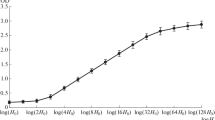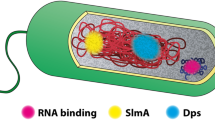Abstract
Recently, it was shown that a short exposure of living mammalian cells to low ionic strength buffers (hypotonic shock) caused partial or almost complete unraveling of interphase nucleoli. However, when the cells were released from the hypotonic shock and transferred to normal isotonic medium, functionally active and structurally integral nucleoli were reassembled at their initial positions within interphase nuclei. Here, we show further that this process is accompanied by the appearance of numerous discrete extranucleolar bodies, which have striking similarities to the prenucleolar bodies (PNBs) observed in untreated cells at telophase of mitosis. (1) Like PNBs at mitosis, hypotonically induced interphase PNBs are composed of RNA-positive granules and fibrils, contain the major nucleolar protein B23 and silver-binding proteins, but lack DNA and RNA polymerase I transcription factor UBF. (2) As for mitotic PNBs, disappearance of the interphase PNB counterparts coincides with the increase in size of reconstructed nucleoli. (3) Addition of actinomycin D does not prevent assembly of interphase PNBs, but does arrest their coalescence with the chromosomal nucleolus-organizing regions and blocks the complete reformation of nucleoli. It is concluded that the assembly of PNBs generally observed at telophase of mitosis can be induced experimentally in nuclei of interphase mammalian cells in vivo. At interphase, this process is probably initiated by changes in the intracellular ionic environment.
Similar content being viewed by others
References
Azum-Gélade M-C, Noaillac-Depeyre J, Caizergues-Ferrer M, Gas N (1994) Cell cycle redistribution of U3 snRNA and fibrillarin. Presence in the cytoplasmic nucleolus remnant and in the prenucleolar bodies at telophase. J Cell Sci 107:463–475
Baran V, Veselá J, Rehák P, Koppel J, Fléchon JE (1995) Localization of fibrillarin and nucleolin in nucleoli of mouse preimplantation embryos. Mol Reprod Dev 40:305–310
Bauer DW, Murphy C, Wu Z, Wu C-HH, Gall JG (1994) In vitro assembly of coiled bodies inXenopus egg extract. Mol Biol Cell 5:633–644
Bell P, Dabauvalle MC, Scheer U (1992) In vitro assembly of prenucleolar bodies inXenopus egg extract. J Cell Biol 118:1297–1304
Benavente R, Rose KM, Reimer G, Hügle-Dörr B, Scheer U (1987) Inhibition of nucleolar reformation after microinjection of antibodies to RNA polymerase I into mitotic cells. J Cell Biol 105:1483–1491
Bernhard W (1969) A new staining procedure for electron microscopical cytology. J Ultrastruct Res 27:250–265
Berridge MJ (1995) Calcium signalling and cell proliferation. BioEssays 17:491–500
Carmo-Fonseca M, Pepperkok R, Carvalho MT, Lamond AI (1992) Transcription-dependent colocalization of the U1, U2, U4/U6 and U5 snRNPs in coiled bodies. J Cell Biol 117:1–14
Davis L, Cadrin M, Brown DL, Chaly N (1993) Reversible disassembly of transcriptional domains in lymphocyte nuclei during inhibition of RNA synthesis by DRB. Biol Cell 78:163–180
Dyban AP, Severova EL, Zatsepina OV, Chentsov YS (1990) The silver-stained NOR and argentophilic nuclear proteins in early mouse embryogenesis: a cytological study. Cell Differ Dev 29:165–179
Ferreira J, Carmo-Fonseca M (1995) The biogenesis of the coiled bodies during early mouse development. Development 121:601–612
Filipowicz W, Kiss T (1993) Structure and function of nucleolar snRNPs. Mol Biol Rep 18:149–156
Frey MR, Matera AG (1995) Coiled bodies contain U7 small nuclear RNA and associate with specific DNA sequences in interphase human cells. Proc Natl Acad Sci USA 92:5915–5919
Gall JG, Tsvetkov A, Wu Z, Murphy C (1995) Is the sphere organelle/coiled body a universal nuclear component? Dev Genet 16:25–35
Gas N, Escande ML, Stevens BJ (1985) Immunolocalization of the 100 kDa nuclear protein during the mitotic cycle in CHO cells. Biol Cell 53:209–218
Gilbert N, Lucas L, Klein C, Menager M, Bonnet N, Ploton D (1995) Three-dimensional co-location of RNA polymerase I and DNA during interphase and mitosis by confocal microscopy. J Cell Sci 108:115–125
Gonzalez-Garcia JM, Rufas JS, Antonio C, Suja JA (1995) Nucleolar cycle and localization of NORs in early embryos ofParascaris univalens. Chromosoma 104:287–297
Hadjiolov AA (1985) The nucleolus and ribosome biogenesis. (Cell biology monographs, vol 12) Springer, Vienna, New York, pp 1–268
Hernandez-Verdun D, Gautier T (1994) The chromosomes periphery during mitosis. BioEssays 16:179–185
Hozak P, Geraud G, Hernandez-Verdun D (1992) Revealing nucleolar architecture by low ionic strength treatment. Exp Cell Res 203:128–133
Iggo RD, Jamieson DJ, MacNeill SA, Southgate J, McPheat J, Lane DP (1991) p68 RNA helicase: identification of a nucleolar form and cloning of related genes containing a conserved intron in yeasts. Mol Cell Biol 11:1326–1333
Jiménez-Garcia LF, Rothblum LI, Busch H, Ochs RL (1989) Nucleologenesis: use of non-isotopic in situ hybridization and immunocytochemistry to compare the localization of rDNA and nucleolar proteins during mitosis. Biol Cell 65:239–246
Jiménez-Garcia LF, Segura-Valdez MdeL, Ochs RL, Rothblum LI, Ross H, Spector DL (1994) Nucleologenesis: U3 snRNA-containing prenucleolar bodies move to sites of active pre-rRNA transcription after mitosis. Mol Biol Cell 5:955–966
Lepoint A, Goessens G (1978) Nucleologenesis in Ehrlich tumour cells. Exp Cell Res 117:89–94
Masson C, Andre C, Arnoult J, Geraud G, Hernandez-Verdun D (1990) A 116000 Mr nucleolar antigen specific for the dense fibrillar component of the nucleoli. J Cell Sci 95:371–381
Means AR (1994) Calcium, calmodulin and cell cycle regulation. FEBS Lett 347:1–4
Medina FJ, Cerdido A, Fernandez-Gomez ME (1995) Components of the nucleolar processing complex (pre-rRNA, fibrillarin and nucleolin) colocalize during mitosis and are incorporated to daughter cell nucleoli. Exp Cell Res 221:111–125
Morcillo G, de la Torre C (1979) Mapping nucleologenesis in relation to transcription. Biol Cell 36:1–6
Morcillo G, de la Torre C (1980) The effect of RNA synthesis inhibitors on prenucleolar bodies. Experientia 36:836–837
Mowry KL, Steitz JA (1987) Identification of the human U7 snRNP as one of several factors involved in the 3′ end maturation of histone premessenger RNA's. Science 238:1682–1687
Ochs R, Lischwe M, O'Leary P, Busch H (1983) Localization of nucleolar phosphoproteins B23 and C23 during mitosis. Exp Cell Res 146:139–149
Ochs RL, Lischwe M, Shen E, Carrol RE, Busch H (1985) Nucleologenesis: composition and fate of prenucleolar bodies. Chromosoma 92:330–336
Olson MOJ (1991) The role of proteins in nuclear structure and function. In: Straus PR, Wilson SH (eds), The eukaryotic nucleus: molecular biochemistry and macromolecular assemblies 2. The Telford Press, Caldwell New York, pp 541–596
Pai CY, Chen HK, Sheu HL, Yeh NH (1995) Cell cycle-dependent alterations of a highly phosphorylated nucleolar protein p130 are associated with nucleologenesis. J Cell Sci 108:1911–1920
Pierron G, Puvion-Dutilleul F (1993) Mitotic segregation of the nucleolar ribosomal RNA inPhysarum polycephalum. Exp Cell Res 208:509–517
Roussel P, André C, Comai L, Hernandez-Verdun D (1996) The rDNA transcription machinery is assembled during mitosis in active NORs and absent in inactive NORs. J Cell Biol 133:235–246
Scheer U, Benavente R (1990) Functional and dynamic aspects of the mammalian nucleolus. BioEssays 12:14–21
Scheer U, Weisenberger D (1994) The nucleolus. Curr Opin Cell Biol 6:354–359
Scheer U, Thiry M, Goessens G (1993) Structure, function and assembly of the nucleolus. Trends Cell Biol 3:236–241
Schmidt-Zachmann MS, Hügle-Dörr B, Franke WW (1987) A constitutive nucleolar protein identified as a member of the nucleoplasmin family. EMBO J 6:1881–1890
Shaw PJ, Jordan EG (1995) The nucleolus. Annu Rev Cell Dev Biol 11:93–121
Shinozuka H, Martin JT, Farber JL (1973) The induction of fibrillar nucleoli in rat liver cells by D-galactosamine and their subsequent re-formation into normal nucleoli. J Ultrastruct Res 44:279–292
Stevens BJ (1965) The fine structure of the nucleolus during mitosis in the grasshopper neuroblast cell. J Cell Biol 24:349–368
Thiry M (1992) Ultrastructural detection of DNA within the nucleolus by sensitive molecular immunocytochemistry. Exp Cell Res 200:135–144
Trendelenburg MF, Zatsepina OV, Waschek T, Schlegel W, Tröster H, Rudolph D, Schmahl G, Spring H (1996) Multiparameter microscopic analysis of nucleolar structure and ribosomal gene transcription. Histochem Cell Biol 106:167–192
Trimbur GM, Walsh CJ (1993) Nucleolus-like morphology produced during the in vitro reassociation of nucleolar components. J Cell Biol 122:753–766
Vanden Broeck J, De Loof A, Callaerts P (1992) Electrical-ionic control of gene expression. Int J Biochem 24:1907–1916
Weisenberger D, Scheer U (1995) A possible mechanism for the inhibition of ribosomal RNA gene transcription during mitosis. J Cell Biol 129:561–575
Yung BY, Bor AM, Chan PK (1990) Short exposure to actinomycin D induces “reversible” translocation of protein B23 as well as “reversible” inhibition of cell growth and RNA synthesis in HeLa cells. Cancer Res 50:5987–5991
Zatsepina OV, Polyakov VYu, Chentsov YuS (1989) Differential decondensation of mitotic chromosomes during hypotonic treatment of living cells as a possible cause of G-banding: an ultrastructural study. Chromosoma 98:109–116
Zatsepina OV, Voit R, Grummt I, Spring H, Semenov M, Trendelenburg MF (1993) The RNA polymerase I-specific transcription initiation factor UBF is associated with transcriptionally active and inactive ribosomal genes. Chromosoma 103:599–611
Zatsepina OV, Dudnic OA, Chentsov YS, Thiry M, Spring H, Trendelenburg MF (1997a) Reassembly of functional nucleoli following in situ unraveling by low ionic strength treatments of cultured mammalian cells. Exp Cell Res (in press)
Zatsepina OV, Todorov IT, Philipova RN, Krachmarov CP, Trendelenburg MF, Jordan EG (1997b) Cell cycle-dependent translocations of a major nucleolar phosphoprotein, B23, and some characteristics of its variants. Eur J Cell Biol (in press)
Author information
Authors and Affiliations
Corresponding author
Additional information
Edited by: S.A. Gerbi
Rights and permissions
About this article
Cite this article
Zatsepina, O.V., Dudnic, O.A., Todorov, I.T. et al. Experimental induction of prenucleolar bodies (PNBs) in interphase cells: interphase PNBs show similar characteristics as those typically observed at telophase of mitosis in untreated cells. Chromosoma 105, 418–430 (1997). https://doi.org/10.1007/BF02510478
Received:
Revised:
Accepted:
Issue Date:
DOI: https://doi.org/10.1007/BF02510478




